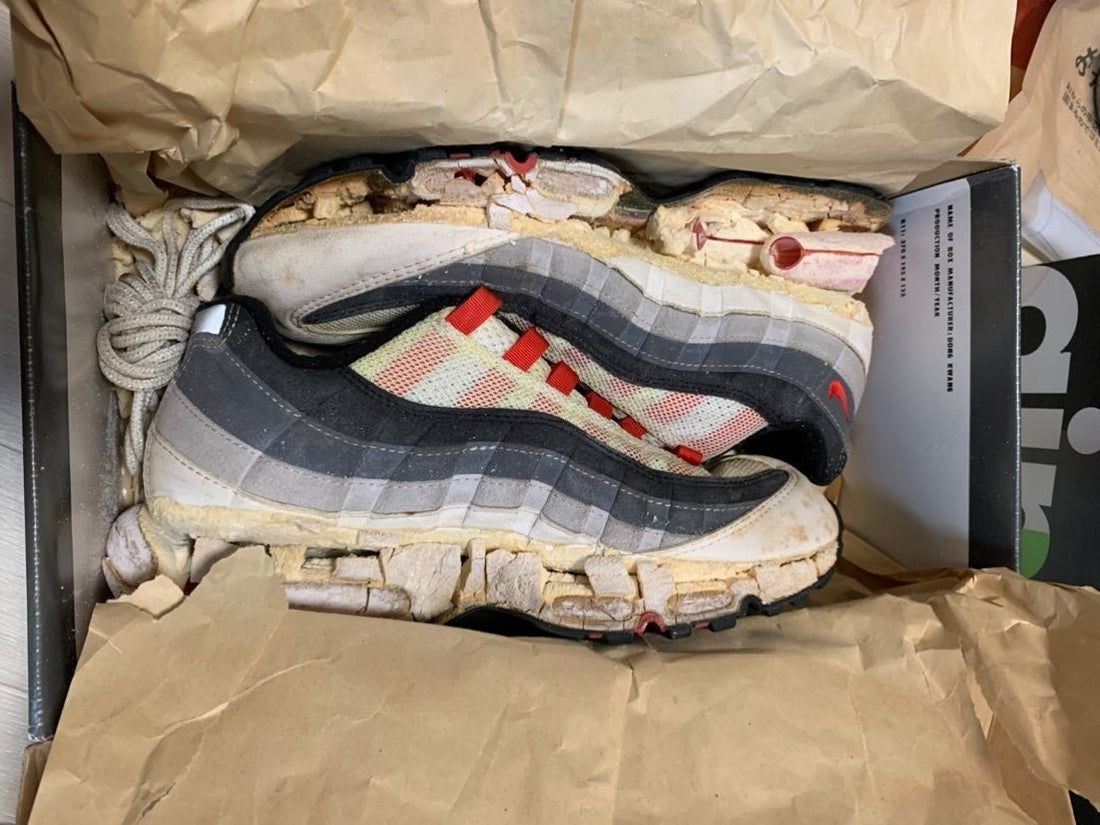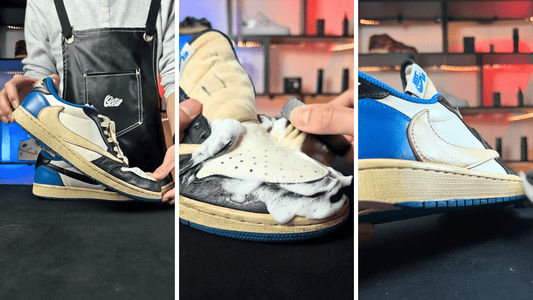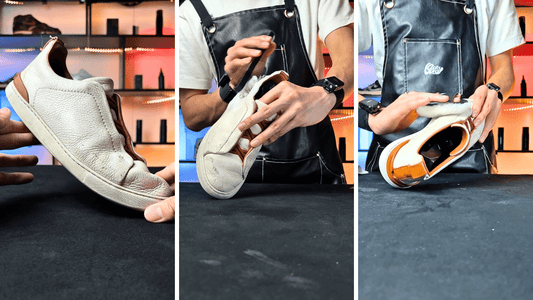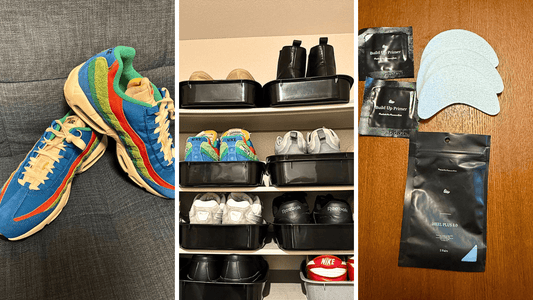You want to keep your favorite sneakers in good condition for as long as possible.
However, hydrolysis is an unavoidable deterioration process that most sneakers on the market undergo.
- When you touch the sole, it crumbles.
- The sole peeled off
- The opening feels sticky
The symptoms described above are signs of hydrolysis, a well-known cause of deterioration in sneakers.
All of these are pretty serious signs of deterioration for sneakers, which serve as footwear.
So why does this deterioration occur?
In this article, we will explain the mechanism of hydrolysis of sneakers and its causes.
The article will also touch on sneakers that do not hydrolyze, so be sure to read it.
Introducing the actual sneakers that have been hydrolyzed
If you're a sneaker fanatic, you may have already experienced hydrolysis in some of your sneakers.
However, for those who have only recently become interested in sneakers, it may be difficult to understand just by reading the features in words.
So, to start with, I'd like to show you two pictures of sneakers that have actually undergone hydrolysis.

First, the representative of hydrolysis: NIKE / Air Max 95
Although the silhouette of a sneaker has somehow been maintained, the midsole has hydrolyzed badly and is so worn out that it is impossible to wear them.

Next up is the NIKE / AIR JORDAN 4, which is also known for being easily hydrolyzed.
In this case, the midsole has completely disintegrated due to hydrolysis, to the point where it no longer resembles a sneaker.
The two types of sneakers given as examples here are both in a state where hydrolysis has progressed completely, so you could say they are the final form of hydrolyzed sneakers.
However, once symptoms of hydrolysis begin to appear, it is only a matter of time before the product reaches the state shown in the photo.
Now, after you have seen the actual product, we will explain why this happens and the mechanism and causes of hydrolysis.
The mechanism and cause of the classic sneaker deterioration process, hydrolysis

Unfortunately , hydrolysis is a type of degradation that cannot be prevented .
What's more, hydrolysis begins at the time of production, long before the sneakers reach your hands.
You may be wondering "That long ago?", but the answer lies in the mechanism of hydrolysis.
Mechanism of hydrolysis
Sneaker soles often use a sponge-like material called polyurethane foam to reduce weight and provide cushioning.
Although it cannot be seen with the naked eye, its sponge shape means that it has many tiny holes.
The phenomenon in which moisture penetrates these tiny holes and breaks down the bonds between the molecules that make up the polyurethane is called hydrolysis.
In other words, things that were originally stuck together are pulled apart by a foreign object that gets in between, causing the shape to become distorted.
If we apply the above to sneakers, it would mean that the bonds in the polyurethane that make up the sole break down, causing the sole to fall apart.
By the way, hydrolysis is not limited to soles; it can also affect the adhesives used to bond the materials in the shoe, leading to stickiness and peeling between materials.
Causes of hydrolysis
Water breaks down the bonds between molecules
In other words, water is the cause of hydrolysis.
The moisture that affects sneakers is
- Moisture in the air
- Human sweat
- Gets wet directly from rain, etc.
As mentioned above, if you think about it for a moment, you will find that the causes are lurking in places very close to you.
The reason I said earlier that "hydrolysis begins at the time of manufacturing" is because the polyurethane material is exposed to moisture in the air from the moment it is formed into sneakers.
The hydrolysis of sneakers is explained in detail on YouTube at the link below, so be sure to check it out if you want to watch the video.
Introduction to sneakers that are prone to hydrolysis and those that are not

Most of the sneakers currently on the market are prone to hydrolysis.
However, there are some models that do not hydrolyze depending on the materials used in the sneakers.
In this section, we will introduce some representative sneakers that are prone to hydrolysis and those that are not.
Sneakers that are prone to hydrolysis
- NIKE / AIR MAX
- NIKE / AIR JORDAN 2 and later models
- NIKE / AIR MORE UPTEMPO
All of these sneakers use polyurethane in the soles, so deterioration due to hydrolysis is unavoidable.
As shown in the photo at the beginning, hydrolysis of the AIR MAX 95 is quite well known, so many people may already know about it.
This time we have introduced three NIKE models that are prone to hydrolysis, but of course there are many models from other manufacturers such as New Balance, Adidas, and Reebok that are also subject to hydrolysis.
So-called "high-tech sneakers" often use polyurethane in the soles, which makes them prone to hydrolysis.
Hydrolysis-resistant sneakers
All three sneakers have rubber soles, so the soles will not deteriorate due to hydrolysis.
In particular, the CT70 and OLD SKOOL are mostly made of a combination of canvas fabric and rubber soles, making them extremely durable.
However, due to the nature of rubber, rubber soles may gradually harden over time and lose their cushioning properties.
It cannot be said with certainty that all rubber soles will harden, but it is good to keep in mind that this is a possibility.
3 ways to prevent hydrolysis of sneakers

As mentioned at the beginning, hydrolysis is a type of deterioration that cannot be prevented .
However, by taking appropriate measures, the progress of hydrolysis can be significantly slowed.
The measures are as follows:
- Humidity Control
- Wear regularly
- Choosing the right storage method and location
The above three are ways to prevent hydrolysis.
We will explain each one in detail.
Humidity Control
The most reliable and hassle-free method is to put silica gel (a desiccant) in your sneakers .
Of course, you can also use a dehumidifier.
However, when you consider the costs involved, such as installation fees and daily electricity bills, it is true that humidity control with a dehumidifier can be quite difficult.
In comparison, desiccants are cost-effective and simply require you to place them inside your sneakers, making them the perfect item to prevent moisture in your sneakers.
Moisture will accumulate inside your sneakers not only when you wear them on a rainy day, but also when your feet sweat, so be sure to put a desiccant such as silica gel inside to thoroughly dehumidify them.
In particular, Japan has a hot and humid environment, so silica gel is an essential item when storing products indoors.
Wear regularly
There are various theories, but it is sometimes said that wearing shoes regularly is the best way to prevent hydrolysis.
Wearing sneakers puts moderate pressure on the soles , helping to push out any moisture that has seeped into the gaps in the polyurethane.
When it comes to rare sneakers, you might be hesitant to wear them because you're worried about scratching them.
However, wearing them regularly will actually extend their lifespan, so unless it's a model you want to collect unworn, we recommend making a conscious effort to wear them.
Choosing the right storage method and location
-
For models you wear regularly, use a desiccant or a desiccant + sneaker box
- Collection without wearing → Desiccant + wrapping film + sneaker box
As with the combinations above, we recommend changing your storage method depending on how often you wear your shoes.
Storing your sneakers in the wrong way, such as leaving them in a humid place without any moisture protection, will definitely shorten their lifespan.
If you have a rare model that you collect without ever wearing it, be sure to take more effective measures to prevent moisture from affecting its value.
By the way, KicksWrap's wrapping film only has one hole for venting air, at the toe.
This means that your sneakers are protected from moisture in the air to the maximum extent possible.
The Premium model also has UV protection, making it the perfect item for storing your sneakers.
Frequently asked questions about hydrolysis of sneakers

I am often asked about hydrolysis of sneakers.
- Repairability
- How many years does it take to hydrolyze?
I would like to touch upon these two points as well.
Can sneakers be repaired if they have been hydrolyzed?
A: Yes and no.
It is impossible to repair sneakers that have been damaged by hydrolysis on their own.
Unfortunately, there is no way to restore polyurethane that has deteriorated to its pre-hydrolysis state.
However, there is a method called "sole swap," in which a different sole is transplanted into a sneaker whose sole has been damaged by hydrolysis.
However, even with sole swaps, it is true that it is very difficult to restore the shoe to the exact same condition it was in before hydrolysis.
There are two reasons for this.
- You need to have the exact same model and the same size sole.
- The condition is that the sole used as replacement material is not deteriorated.
To restore the sneakers to their pre-hydrolysis state like this, it would be necessary to purchase another pair of the same sneakers, which would be a significant financial burden.
Furthermore, the soles used as replacement materials must not have been hydrolyzed, so they may be difficult to find for models that have been on the market for many years.
Taking all of this into consideration, repairing hydrolyzed sneakers is possible, but nearly impossible.
How many years does it take for sneakers to hydrolyze?
A: The most common answer is about 10 years. However...
The claim that it will last for 10 years is true in America, where the air is very dry.
In humid Japan, the recommended period is 5 to 7 years.
Of course, it depends on how you stored them, how often you wore them, and the model, so it's difficult to say for sure how old they are.
It may not even last five years, but it's entirely possible for it to last eight years without you doing anything.
One thing to note is that the Japanese climate is not very friendly to sneakers, so keep in mind that sneakers have a shorter lifespan than in the United States, for example.
summary
Many models of sneakers currently on the market, including rare premium sneakers, use polyurethane soles.
Hydrolysis begins at the time of production, so it is impossible to completely prevent this deterioration.
However, it is certain that proper storage methods can extend the lifespan of your item compared to not taking any precautions.
Just putting a desiccant inside can make a big difference, so we recommend taking measures to prevent hydrolysis that suit your style.




















